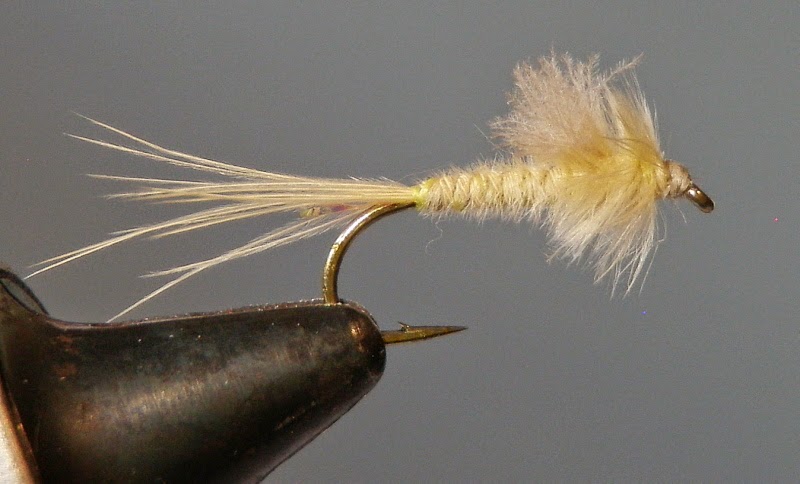 |
| Callibeatis |
Twisted Emerger
The first version of this fly came about from watching callibeatis hatch from my float tube. As I slowly paddled around on a late morning in July I could see the speckled gray wings pop up out of the surface and fly away within seconds. The trout were leisurely feeding on the emergers at the point they bobbed up into the film.
The first version of this fly came about from watching callibeatis hatch from my float tube. As I slowly paddled around on a late morning in July I could see the speckled gray wings pop up out of the surface and fly away within seconds. The trout were leisurely feeding on the emergers at the point they bobbed up into the film.
I put my rod down and moved to
where the heaviest callibeatis activity was at the time. Slowly kicking across
the windless surface of the lake I stared down into the ultra-clear water. The
first emergence I saw didn't register until the wings popped out of the insect’s
husk. The next one caught my eye immediately and I was able to witness the
transformation. For the next hour or so I just wandered around the surface of
the lake watching while the wheels turned in my head.
 |
| Callibeatis Tan |
As the nymphs rose to the surface
I could see the gas bubble in husk and the bubble at the tail. It was much the
same as I had witnessed when the idea for the Popcorn Midge popped into my head
the spring before. This also confirmed why the Soft Hackle Emerger had always
been so effective. I was able to witness first hand these emerging nymphs being
intercepted by the trout as they headed for the surface. The ones that made it
to the surface suspended there from 2-3 seconds to 15 seconds before their husk
broke and allowed them to pop out into the world above the water’s surface.
This was when most of the emergers were taken.
 |
| BWO Olive |
It took some tinkering with the
original idea to eventually come up with the Twisted Emerger that actually
worked. The May-E Merger and Film Star are incarnations that have proved
successful in slightly different situations.
 |
| BWO Olive Brown |
Since its inception I have
effectively fished versions of the Twisted Emerger in lakes and rivers.
FISHING
The Twisted Emerger is designed
to be fished on the surface film. Although it was originally intended for
stillwaters it has proven extremely effective in moving water also. For the
most part it is most effective on flat or moderately broken water. The CDC wing
allows the fly to be fished dry without any dressing. The body and tail of the
fly will, when wet, penetrate the surface film and suspend horizontally just
under the surface. This allows the fly to be seen by the trout from some
distance. I have witnessed fish move several feet across or upstream to
intercept these flies.
 |
| PMD Yellow Olive |
During hatches of mayflies on
still and moving waters there is a period when the emerging insect is for lack
of a better word stuck in the surface film inside its shuck. This is only an
instant in the life of the insect but the most opportune moment for trout to
take them. This is the reason trout will many times slash with what appears to
be total abandon at the emergers. They recognize the window of opportunity but
also recognize it to be a short one.
 |
| Callibeatis Ginger |
On moving water fish the fly on a
moderate to long leader of 9-15 feet. Grease all but the last 12 inches of the
leader using a good paste floatant to keep it from sinking and putting downward
drag on the fly. As a general rule it is best to present the fly upstream of
the feeding trout with a drag free drift. However there have been a number of
occasions when very slight twitches will induce strikes from otherwise wary
trout. It’s important to keep in mind that the insect you’re imitating is
struggling to get free of its shuck. The marabou used to tie the fly generally
imitates this movement sufficiently but sometimes a little extra helps.
 |
| Callibeatis Pale Olive |
The only downside to this fly, if
it can be called that, is the CDC needs to be dried after catching a fish if it
becomes “slimed”. To do so place it underwater and gently rub the CDC between
your fingers. Dry the surface of the fly on a piece of cloth then false cast on
a short line several times to fluff the CDC. Once the CDC is fluffed the fly is
ready to fish. I find this to be a minor inconvenience for such an effective
fly.
Available in -
BWO - Dark Olive, Olive Brown, Olive, Pale Olive
Size 16 - 24
Callibeatis - Tan, Pale Olive, Ginger
Size 12 -16
PMD - Light Olive, Yellow Olive
Size 14-20

No comments:
Post a Comment